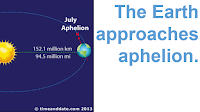The Southern Delta Aquariid Meteor Shower is visible between roughly 12 July and 23 August each year, and is expected to peak on Sunday 30 July this year, producing up to 25 meteors per hour. Best viewing this year is predicted to be between 3.00 am (this will be in local time wherever they are viewed from, as the time reflects the orientation of the planet to the rest of the Solar System) and dawn, when the radiant point of the shower (point from which the meteors appear to radiate), which is close to the star Delta Aquari (hence the name) will be highest in the sky. Unfortunately, this year the Moon will be full on Tuesday 1 August, and will be in the constellation of Sagittarius, so that light interference from the Moon is likely to hamper observations of the Southern Delta Aquariid Meteors.
Meteor streams are thought to come from dust shed by comets as they come close to the Sun and their icy surfaces begin to evaporate away. Although the dust is separated from the comet, it continues to orbit the Sun on roughly the same orbital path, creating a visible meteor shower when the Earth crosses that path, and flecks of dust burn in the upper atmosphere, due to friction with the atmosphere.
The Southern Delta Aquariids are thought to be caused by the Earth passing through the trail of Comet 96P/Machholz, where it encounters thousands of tiny dust particles shed from the comet as its icy surface is melted (strictly sublimated) by the heat of the Sun. 96P/Machholz is a short period, Jupiter Family Comet, crossing our orbit every 5.24 years, but the trail of particles shed by it forms a constant flow.
96P/Machholz was discovered by amateur astronomer Donald Machholz from Loma Peak in California; the name 96P/Machholz implies that it was discovered by Machholz and was the 96th periodic comet discovered (a periodic comet is a comet which orbits the Sun in less than 200 years).
96P/Machholz has an orbital period of 1929 days (5.28 years) and a highly eccentric orbit tilted at an angle of 58.5° to the plain of the Solar System, that brings it from 0.12 AU from the Sun at perihelion (12% of the distance between the Earth and the Sun, considerably inside the orbit of Mercury, and closer to the Sun than any other known periodic comet); to 5.94 AU from the Sun at aphelion (5.94 times as far from the Sun as the Earth or slightly more than the distance at which Jupiter orbits). As a comet with a period of less than 20 years, 96P/Machholz is considered to be a Jupiter Family Comet.
See also...
Follow Sciency Thoughts on Facebook.
Follow Sciency Thoughts on Twitter.




.jpg)





